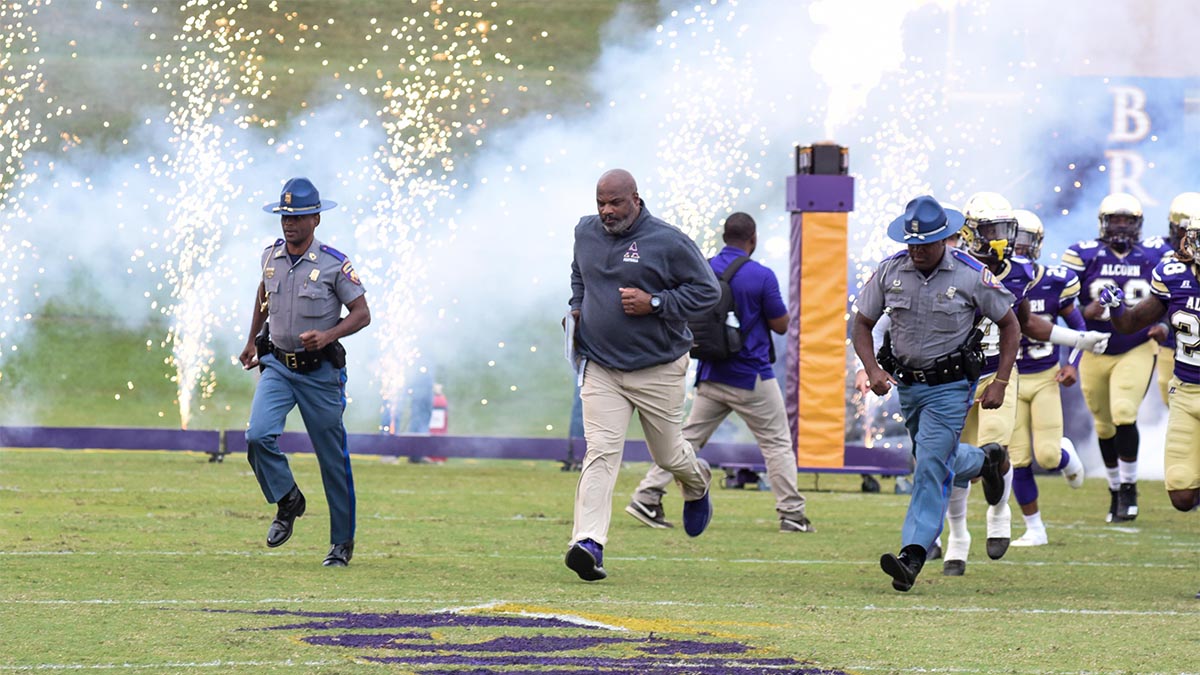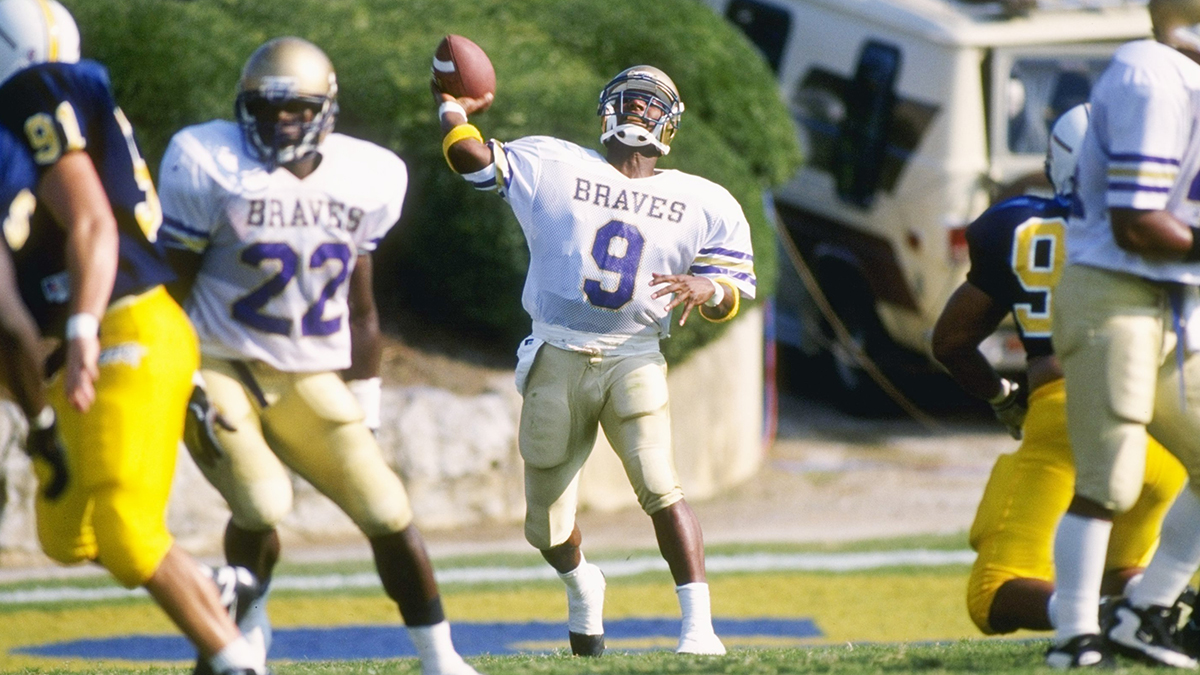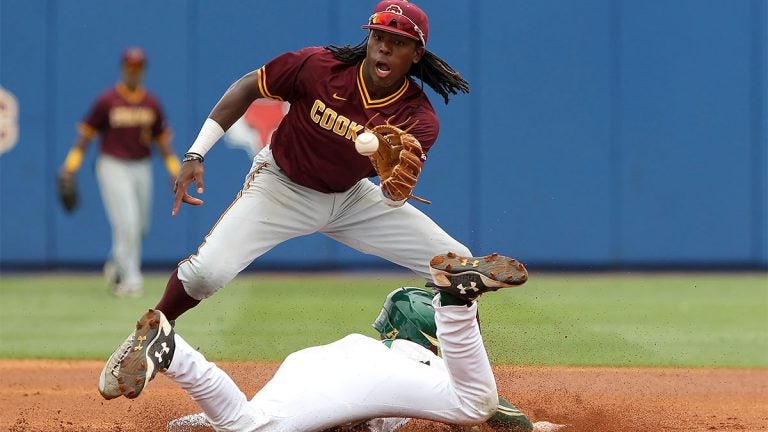Integration, financial struggles putting HBCU football on the brink
Why this matters
While historically black colleges and universities at one time played a leading role in educating and producing athletes, those institutions now struggle to stay alive and relevant in athletics.
From Buck Buchanan to Walter Payton, the list of players who attended historically black colleges and universities (HBCUs) reads like a who’s who among football greats. In fact, 30 such players are enshrined in the Pro Football Hall of Fame.
They attended schools such as Bethune-Cookman, Jackson State, MississippiValley State, Florida A&M and Grambling State. Several did so in an era — the 1950s through the 1970s — when many colleges and universities, especially in the south, either had yet to admit or only recently begun admitting African-American students. As a result, HBCU football programs were powerhouses loaded with gridiron talent.
And HBCUs can trace their football history almost as far back as the college game itself. The first college football game took place in New Brunswick, N.J., on Nov. 6, 1869 when Princeton played at Rutgers. This year marks the 150th anniversary of that game. Twenty-three years later, in 1892, the first game between HBCUs took place when Livingstone College and Biddle College, known today as Johnson C. Smith, met in Charlotte.
Long before that game, however, HBCUs had been making their mark on American history. Cheyney and Lincoln universities — the latter changed its name in 1866 to honor the 16th president — were founded prior to the Civil War, giving black youth education opportunities they had been largely denied.
Though a number of solid programs exist today, the HBCU football landscape has changed dramatically since the mid-1970s. The integration of historically white football-playing institutions, financial struggles at many HBCUs and the dramatic increase in the number of football-playing schools at the Division I level are behind the general decline in HBCU football.
“If you go back to the 1960s and 1970s, African-American athletes really didn’t have much of a choice, and that really made for an extremely high level of talent at the HBCUs,” said Jason Cable, senior associate commissioner for administration at the SWAC.
Jim Crow laws enforced racial segregation in the south after Reconstruction until the civil rights movement of the 1950s and 1960s, which ushered in the era when traditionally white universities began admitting African-American students.
“When you get into the 1980s, 1990s and the 2000s, the opportunities have increased and have had an adverse effect on the type of student-athletes HBCUs have been able to find,” said Cable.
Cheyney has had trouble far beyond finding student-athletes. The university eliminated its football program following the 2017 season amid declining enrollment and financial constraints. Located about a half-hour’s drive outside Philadelphia, the institution was founded in 1837, making it the nation’s first HBCU. The school began playing football in 1914.
Reports in 2019 indicated the school was $43 million in debt, a figure that could grow to more than $80 million when taking into account money owed to state and federal government agencies. Cheyney, one of 14 state schools in Pennsylvania, saw its enrollment fall 38 percent in a one-year period ending in the fall of 2018.
In March 2018, the school withdrew from the NCAA and dropped out of the Division II Pennsylvania State Athletic Conference, which requires its schools to be NCAA affiliated. The school offers three sports, men’s and women’s basketball and women’s volleyball, and competes as a Division II independent.
“It is a loss for us to not have that association, to have all of our student-athletes with the experience to visit the campus and the history and tradition it has,” PSAC commissioner Steve Murray said. “Athletics is an enrollment driver, and now there are 60 kids that may not be there because they attended Cheyney to get an education and play football. With football and the resources and commitment it requires, I think it just became too much for the institution to sustain.”
The elimination of the football program and the struggles of an HBCU pillar drew everyone’s attention.
“It’s definitely a reality check,” said Grambling State director of athletics David Ponton, who has spent more than 25 years in a variety of roles at the Louisiana institution, including as vice president for student affairs. “It lets you know, even with a rich tradition and history, what can happen if you are not financially viable.”
The reality, as Cable indicated, is more opportunities exist for student-athletes who might have considered an HBCU.
In 2018, 255 colleges and universities played at the two highest levels of college football, the Football Bowl Subdivision (FBS) and the Football Championship Subdivision (FCS). The latter group includes the two most prominent HBCU conferences: the Mid-Eastern Athletic Conference (MEAC) and the Southwest Athletic Conference (SWAC). That total is 72 more than 1980 when the two levels were known as Division I-A and Division I-AA, respectively. Overall, a record 778 institutions fielded football teams in 2018.
“There are a lot more opportunities now that were not available, say, during the era of the baby boomers,” said Sam Washington, who played at Mississippi Valley State from 1979 to 1982 and is the head coach at North Carolina A&T, the most successful HBCU in recent years. “Now, the millennials have so many opportunities as far as universities.”
Many of those universities have athletic departments that are in much better shape financially. Though Cable noted some schools in the SWAC and MEAC recently upgraded facilities, nine schools from those conferences were among the bottom 12 of 230 Division I public institutions when it came to total athletic revenue for 2016-17. The other three schools on the list do not have a football team.
Without steady revenue streams, schools find it difficult to maintain athletic facilities, let alone upgrade. When facilities are lacking, or outdated, student-athletes are likely to look elsewhere, especially a football player with aspirations of playing at the next level.
“Student-athletes these days want to be in an environment that is big and bold and glistening, that kind of thing,” Ponton said. “From a recruiting standpoint, that is always a challenge, being able to recruit black athletes with minimal resources as far as facilities and infrastructure. Because of those challenges, kids are looking elsewhere. There are many more opportunities out there.”
Grambling has the biggest name recognition among HBCUs due to the success enjoyed by the football program under the legendary Eddie Robinson, who won 408 games in his 55 seasons on the Tigers’ sideline. The program claims many of the game’s all-time greats such as Willie Brown, Willie Davis, Doug Williams, Charlie Joiner and Buchanan.
Even with that tradition, the school faces an uphill battle. Ponton noted state support has dwindled to $13 million from $32 million of 10 years ago.
“When you see Grambling, you think of Eddie Robinson and football,” he said. “We have a marketing tool with our name, and we are able to do some things that maybe some other schools may not be able to. However, even with all of those things, we are still underfunded. We are still challenged, and it is something that is unending and you are constantly trying to rebuild and catch up. You have a lot of Division II schools, which, financially speaking, are in a better situation than what some of our HBCU Division I schools are.”
Maintaining an athletic program, and specifically a football team because of its size, at a time when a university is struggling to keep its head above water can lead to unfortunate but necessary decisions.

“The greatest challenge for HBCUs is to build and sustain athletic programs that do not unduly drain an institution’s primary investment in their academic programs,” said Harry Williams, president and CEO of the Thurgood Marshall College Fund, in a 2018 report on HBCU sustainability. “Several HBCUs have responded to this challenge by eliminating athletic programs, especially football, because of declining enrollments and the unsustainable costs of maintaining such programs.”
Bethune-Cookman University in Daytona Beach, Fla., was the subject of speculation it would have to go beyond eliminating athletic programs. Founded in 1904 and possessing a rich history on the gridiron that includes five MEAC titles this decade, including four straight (2012-15), the university has been in such serious financial trouble from “years of inexcusable management decisions” there were rumors the school was going to close.
At a time when many HBCUs are struggling, however, Florida Memorial University is relaunching its football program in 2020. The private school, based in Miami Gardens, last fielded a team in 1958 when the institution was located in St. Augustine and known as the Florida Normal and Industrial College.
“The administration, the board of trustees all want to see it work and did what they had to do to put us in a situation in order to roll out football,” said athletic director Ernest Jones, who played at Alcorn State with the late Steve McNair in the 1990s and has been a coach and administrator at several HBCU and non-HBCU universities, including serving as the director of player development at Notre Dame. “They sat down and went through every detail to make sure that they get it right. I think having strong leadership, a strong athletic director and strong coaches who know and understand (the process), that is how you are successful at the HBCU level, in my opinion.”
Though FMU is not a member of the NCAA — the school is a member of the National Association of Intercollegiate Athletics (NAIA), which governs about 250 small colleges and universities — it faces many of the same challenges in attracting student-athletes.
“When kids visit, they want to see the weight room, they want to see the cafeteria, they want to see the dorm rooms, they want to see the meeting rooms and they want to see the playing and practice surfaces,” Jones said. “If you are not at the level of the three or four other schools they looked at, you don’t have a chance. We think that we are in an attractive situation because people want to come to South Florida. We have a beautiful campus and we have top-notch facilities.”
North Carolina A&T’s Washington attended and has been an assistant or head coach at six HBCUs. He believes a school needs something it can sell.
“I don’t think all of the HBCUs have grown with today’s society and don’t compete academically,” he said. “There are some that do, but there are many that don’t. We are fortunate here that we can hang our hat on our engineering program. However, there are several schools that don’t have much with which to hang their hat. Until they do, many (HBCUs) are going to struggle.”
And when it comes to facilities, stagnation is the equivalent of falling behind.
When Jones returned to Alcorn State as head coach in 2008, a decade after he graduated, he saw that little, if anything, had changed from his playing days at the school.
“When I went back as the head coach 10 years later, everything was exactly the same, even the chairs in the meeting room,” he said. “That is part of the reason these programs are not successful. A lot of these HBCUs remain that way for years and years. You have to have people that are committed to making it work.”
Especially at a time when there are more choices than ever.
“When I was playing, HBCUs were getting some of the top players,” Washington said. “In Mississippi, there were only three schools to compete against: Ole Miss, Mississippi State and Southern Miss. Now, you have so many more and schools in neighboring states are recruiting the same kids. The HBCUs, instead of recruiting some of the cream of the crop, they are not getting the opportunity at any of the cream anymore.”
Washington’s Aggies have been the cream of the HBCUs. They were No. 7 in the final 2017 FCS poll and No. 12 in 2018. In each of the last three years, the team has beaten an FBS program — Kent State, Charlotte and ECU, respectively — and had one player selected in the NFL draft.
The success on the gridiron mirrors that of the institution under the guidance of Chancellor Harold Martin, who was named the most influential HBCU leader for 2016. The school, based in Greensboro, recently experienced a 15-percent enrollment increase, bringing its student population to more than 12,000.
This goes against a recent trend. While all institutions of higher education have experienced a drop in enrollment for much of the past decade, it is more pronounced at HBCUs.
According to a National Center for Education Statistics report the number of students at degree-granting institutions declined six percent from 2010-2017. At HBCUs, of which there are 102 spread among 19 states and the U.S. Virgin Islands, enrollment declined nine percent. Since that report was published, HBCUs have experienced an uptick in enrollment.
“It begins at the top, and Dr. Martin had a vision from the start and knew the direction in which he wanted to go,” said Washington of the success at A&T. “He surrounded himself with really good people, put us on the track and said, ‘Let’s go.’”
The effects of academic offerings affects the athletic department with respect to the type of student-athlete the university attracts.
“There is absolutely a direct correlation,” he said. “That’s what success does. Success breeds success. When you get quality kids anything is possible.”
Though HBCU football is not as prominent as it was, fans still attend games. The top-drawing program in the FCS last season was an HBCU: Jackson State. The school Payton attended averaged 24,770 fans in 2018, according to the National Football Foundation.

North Carolina A&T’s success on the football field resulted in an average attendance of 15,494 last season, which ranked 11th among FCS programs.
At the Division II level, Atlanta-based Morehouse College led the way with an average attendance of 12,037. Tuskegee (Ala.) University checked in at second with an average of 11,058. Both schools are part of the Southern Intercollegiate Athletic Conference.
And the annual Bayou Classic in New Orleans between Grambling and Southern is as strong as ever. Last season’s 45th game in the series attracted 67,871 to the Superdome, the third consecutive year the game drew in excess of 65,000 to see the two traditional HBCU powers. The game is broadcast on NBC.
The Celebration Bowl, first played in 2015, is a matchup between champions of the MEAC and SWAC that is aired on ABC. North Carolina A&T has won three of the four games, including last season’s 24-22 win against Alcorn State in front of 31,672 in Atlanta’s Mercedes-Benz Stadium.
“It’s an opportunity to earn revenue and give people a chance to see what we have to offer,” Alcorn State coach Fred McNair said of the bowl game. “It puts our brand out there, and it is also a good recruiting tool.”
Organizers hope that will be the case with the first Black College Football Hall of Fame Classic between Alabama A&M and Morehouse College on Sept. 1. The game will be played at Tom Benson Stadium in Canton, Ohio, on the campus of the Pro Football Hall of Fame, where the Black College Football Hall of Fame will have a permanent home instead of being a traveling exhibit.
The exposure that game and the two bowl games provide HBCUs is crucial. Something else that could help is an agreement consumated last year between the MEAC and ESPN on the streaming of football games.
“A major determinant for high school students choosing a school to participate in athletics, particularly football, would be (media) exposure and facilities,” Cable said. “Exposure and facilities over the last 20-25 years with HBCUs has created a difficult situation. I think high school students are realizing that you can get exposure through a game like the Celebration Bowl and are understanding that you can get to the NFL from an HBCU institution.”
Tom Layberger has spent more than 25 years as a writer, editor and web producer for various media outlets. Tom, who resides in Tampa, is a graduate of the University of South Florida. Follow him on Twitter @TomLay810





